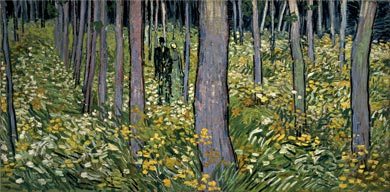

Vincent Van Gogh
Undergrowth with Two Figures, 1890
Oil on canvas. 50 x 100 cm
Cincinnati Art Museum
Bequest of Mary E. Johnston
Undergrowth with Two Figures, 1890
Oil on canvas. 50 x 100 cm
Cincinnati Art Museum
Bequest of Mary E. Johnston

On 20 May 1890, Vincent van Gogh got off the train at Auvers-sur-
Oise, a village situated 35 kilometres from Paris. The artist had
recently left the mental asylum at Saint-Rémy and came to Auvers
in search of better health and tranquillity, hoping to start a new life
and a new cycle in his work as a painter. Just two months later, however,
on 27 July, in the fields near the château de Léry, Van Gogh shot
himself with a revolver, dying in agony in the early morning of 29
July.
While Van Gogh was still a patient at Saint-Rémy his brother Theo had been looking for a peaceful rural location close to Paris where Vincent could lead an independent life but discreetly watched over by a trusted friend. The painter Camille Pissarro suggested the name of Paul-Ferdinand Gachet, a doctor, amateur artist and old friend of some of the Impressionist painters including Pissarro himself, Cézanne and others. Gachet lived in Auvers-sur-Oise, which was one hour by train from the capital.
Van Gogh's Auvers period was brief but extremely productive: in just seventy days the artist produced more than seventy paintings and around thirty drawings. This frenzied rhythm suggests a desperate race against time, as if the artist himself felt his days to be numbered. Before his arrival in Auvers, Vincent had spent three days in Paris at his brother's house where he had been able to see his own paintings, which literally covered the walls of the apartment and were piled up under the bed, the sofa and under the cupboards. This experience of seeing all his work together for the first time had a profound affect on Van Gogh and would determine his work over the following weeks, the last of his life. His final paintings would be a sort of recapitulation or epilogue to his entire career.
1 A Tradition of Landscape Painters
2 Thatched Cottages and New Houses
3 In the Open Fields
4 The Last Series

This website fulfills the norm of accessibility AA.
While Van Gogh was still a patient at Saint-Rémy his brother Theo had been looking for a peaceful rural location close to Paris where Vincent could lead an independent life but discreetly watched over by a trusted friend. The painter Camille Pissarro suggested the name of Paul-Ferdinand Gachet, a doctor, amateur artist and old friend of some of the Impressionist painters including Pissarro himself, Cézanne and others. Gachet lived in Auvers-sur-Oise, which was one hour by train from the capital.
Van Gogh's Auvers period was brief but extremely productive: in just seventy days the artist produced more than seventy paintings and around thirty drawings. This frenzied rhythm suggests a desperate race against time, as if the artist himself felt his days to be numbered. Before his arrival in Auvers, Vincent had spent three days in Paris at his brother's house where he had been able to see his own paintings, which literally covered the walls of the apartment and were piled up under the bed, the sofa and under the cupboards. This experience of seeing all his work together for the first time had a profound affect on Van Gogh and would determine his work over the following weeks, the last of his life. His final paintings would be a sort of recapitulation or epilogue to his entire career.
1 A Tradition of Landscape Painters
2 Thatched Cottages and New Houses
3 In the Open Fields
4 The Last Series

This website fulfills the norm of accessibility AA.



